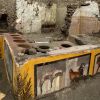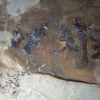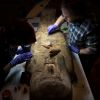-
 +17 +1
+17 +1Archaeologists uncover ancient street food shop in Pompeii
Archaeologists in Pompeii, the city buried in a volcanic eruption in 79 AD, have made the extraordinary find of a frescoed hot food and drinks shop that served up the ancient equivalent of street food to Roman passersby.
-
 +14 +1
+14 +1Ivory from a 16th century shipwreck reveals new details about African elephants
In 2008, miners off the coast of Namibia stumbled upon buried treasure: a sunken Portuguese ship known as the Bom Jesus, which went missing on its way to India in 1533. The trading ship bore a trove of gold and silver coins and other valuable materials. But to a team of archaeologists and biologists, the Bom Jesus’ most precious cargo was a haul of more than 100 elephant tusks — the largest archaeological cargo of African ivory ever discovered.
-
 +10 +1
+10 +1What Did the Stone Age Sound Like?
A team of archaeologists is working to uncover whether ancient objects in South Africa were once used as sound tools to make noise or music.
-
 +3 +1
+3 +1Archaeologists Believe They've Unearthed Jesus's Childhood Home
Archaeologists have unearthed evidence at a place believed to be the historical Jesus of Nazareth’s birthplace. Researcher Ken Dark, a professor at the University of Reading, has a new book about more than a century of archaeological digs at the Nazareth Convent site in the north of modern-day Israel.
-
 +15 +1
+15 +1Archaeologists Discover 12,500-Year-Old Rock Art Portraying Humans and Animals in Remote Amazon Forest
Archaeologists have found tens of thousands of ice-age paintings showcasing animals and humans across a cliff that stretches nearly eight miles in Columbia, from almost 12,500 years ago in the Amazon rainforest.
-
 +19 +1
+19 +1How Archaeologists Are Using Deep Learning to Dig Deeper
Trawling ancient history with neural nets.
-
 +17 +1
+17 +1Archaeologists find 2,150-year-old Petra monument ‘hiding in plain sight’
The archaeologists used satellite imagery to find the platform, which is 184 feet by 161 feet. An interior platform had columns along one end and a huge staircase. Based on pottery studies, the researchers think the platform could be at least 2,150 years old.
-
 +2 +1
+2 +1Ancient Maya Built Sophisticated Water Filters
Ancient Maya in the once-bustling city of Tikal built sophisticated water filters using natural materials they imported from miles away, according to the University of Cincinnati. UC researchers discovered evidence of a filter system at the Corriental reservoir, an important source of drinking water for the ancient Maya in what is now northern Guatemala.
-
 +14 +1
+14 +1Huge cat found etched into desert among Nazca Lines in Peru
Feline geoglyph from 200-100BC emerges during work at Unesco world heritage site
-
 +23 +1
+23 +15,700-year-old Neolithic house discovered by archaeologists in Cork
IRISH ARCHAEOLOGISTS have made an incredible discovery in Cork, having unearthed the foundations of a house from the Neolithic era. The ancient house is believed to be 5,700 years old, and was likely the home of a family from one of the earliest farming communities to have settled in the south of Ireland.
-
 +3 +1
+3 +1Take a tusk, drill holes, weave a rope – and change the course of history
Forty thousand years ago, a stone-age toolmaker carved a curious instrument from mammoth tusk. Twenty centimetres long, the ivory strip has four holes drilled in it, each lined with precisely cut spiral incisions.
-
 +3 +1
+3 +1Archaeologists find the source of Stonehenge sarsen stones
Evidence suggests the monument's Neolithic builders shopped local, for once.
-
 +19 +1
+19 +1New archaeological sites discovered at Gona, Ethiopia
This year Sileshi Semaw, archaeologist at the Centro Nacional de Investigacion sobre la Evolucion humana (CENIEH), has led a new field survey and excavations at Gona (Ethiopia), where new archaeological sites have been discovered at Kilaitoli, a site dated to 14,000 years, where work began in 2019.
-
 +4 +1
+4 +1How a Long-Lost Perfume Got a Second Life After 150 Years Underwater
A team of divers and archaeologists discovered the 19th-century fragrance in a shipwreck off the coast of Bermuda.
-
 +16 +1
+16 +1This is the oldest known string. It was made by a Neandertal
In a new twist on Neandertals’ Stone Age accomplishments, our close evolutionary relatives wound bark fibers into strings that could have been used to make clothes, rope, nets and other practical but perishable items, a new study suggests. A fragment of a string made from three bark fibers was found attached to a stone tool at a French Neandertal site. That tool was embedded in sediment dating from 52,000 to 41,000 years ago, say paleoanthropologist Bruce Hardy of Kenyon College in Gambier, Ohio, and colleagues.
-
 +22 +1
+22 +1Archaeologists Discover Paintings of Goddess in 3,000-Year-Old Mummy's Coffin
Researchers lifted the ancient Egyptian mummy out of her coffin for the first time in 100 years and, to their surprise, uncovered the ancient artworks
-
 +26 +1
+26 +1People built bone circles at the edge of ice sheets, and we don’t know why
As the last Ice Age tightened its hold on Europe, a group of people living near the Don River piled dozens of mammoth bones into a 12.5m (30ft) wide circle. They may have lived in the shelter of the mammoth bones for a while, huddling around fragrant fires of conifer wood and mammoth bone and making stone tools. But the traces they left are so light that it seems they didn’t stay long—or maybe they only visited occasionally.
-
 +23 +1
+23 +1Discovered: 25,000-year-old structure made from the bones of an Ice Age beast
Under layers of dirt, pinpricked with animal burrows and shrubs, archeologists found a circle of mammoth bones — evidence of a dwelling built between 25,063 to 24,490 years ago.
-
 +21 +1
+21 +1Virtual reality can bring ancient cities back to life and improve conservation
New modelling techniques shed light on the ancient city of Ugarit and can help plan effective conservation.
-
 +8 +1
+8 +1The Oldest Known Tattoo Art Found in Egyptian Mummy
Scientists discovered the world’s oldest known tattoo art on an ancient Egyptian mummy exhibited at the British Museum for 100 years. Previously, academics and museum visitors saw only pale and dark spots on the right arm of the mummified man. However, recent infrared research has revealed that the marks are actually tattoos depicting two animals, a giant wild bull and a wild North African goat-like creature.
Submit a link
Start a discussion




















